
Medicine Containers Page Menu: 1 2 3 4 5 6 7 Next>>
Medicine Containers Used In the Golden Age of Piracy, Page 6
Container Closures
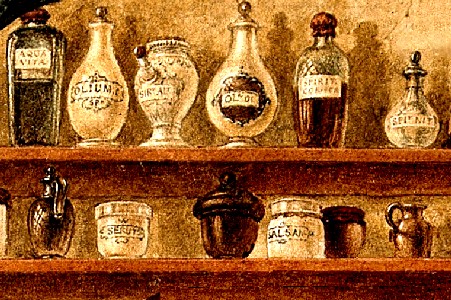
Artist: Jacob Katts
Closures on Barber-surgeon Containers, The Wellcome Collection (1787)
"Let every thing be well covered that the Air hurt them not, nor that they spill, and so you come to damage." (John Moyle, Abstractum Chirurgæ Marinæ, 1686, p. 13)
While there were a fairly wide variety of container types, there were an even larger variety of ways to close the bottles and pots among them. Closures used include corks, glass stopples, pitch and wax stopples, pewter caps, leather, bladders and parchment paper. These different closure methods were often used in combination to provide a more effective seal. To assure a secure fastening, sealants and ties were also used. Let's look at each of these elements.
Container Closures - Corks
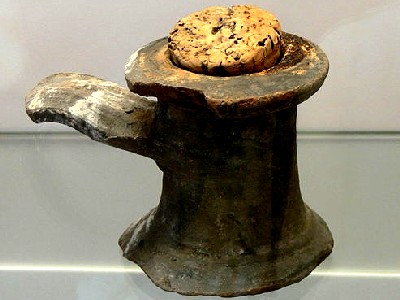
Photo: Wolfgang Sauber - Neck of A Broken Amphora With the Original Cork
The most obvious glass bottle closure from the golden age of piracy would seem to be the cork. Cork used in this way dates back more than 2000 years1; the Greeks and Romans experimented with a variety of closures to seal amphoras including cork.2 The problem with corks as closure devices for these primitive vessels was that the containers were handmade resulting in irregularly-sized spout holes. Corks were also cut by hand and "were as irregular as the necks they sought to plug; cut from the bark face of the cork oak, they formed uneven circles that may or may not have fitted any particular amphora neck."3
Because of this, cloth wrapped wooden stoppers were favored over cork. Corks would not be seriously reconsidered as a bottle closure until the glass and stone bottles became popular in the 15th century.4 Since "Cork’s success as a closure depends upon its fitting snugly into an opening with a relatively uniform diameter."5
Production methods improved during the Renaissance and their popularity a closures for glass bottled beverages exploded in the seventeenth century. "[B]ottled beer is supposed to have been
,_anonymous_painter_17thc.jpg)
Sir Kenelm Digby, Knight (17th century)
invented by Alexander Nowell, the Dean of St. Paul’s Cathedral in London in 1602."6 This may have been the bellwether for the use of corks in bottles.
A variety of cooking and husbandry books from the early and mid seventeenth century refer to the use of corks in bottles. When bottling beer, Hugh Plat advised the reader to make "your corkes very fit for the bottle, and stoppe them close"7 in 1609. Gervase Markham recommended in 1615 that 'bottleale' be "put it into round bottles with narrow mouths, and then stopping them close with cork, set them in a cold cellar up to the waist in sand, and be sure that the corks be fast tied in with strong pack-thread, for fear of rising out, or taking vent, which is the utter spoil of the ale."8 John Beale explained that cider "should be drawn into well cork’d and well bound bottles" in 1664.9 Sir Kenelm Digby wrote that mead should be decanted "into pottle-bottles of glass, not filling them by a fingers breadth or more. Stop them close with Cork tied in, and set them in a cool place for 6, 7 or 8 weeks."10 Digby is also credited with designing a “string rim” on glass bottles which allowed thread to be used to tie the cork down in the 1630s.11 The first recorded reference to using cork in champaign bottles came from the household account of the Duke of Bedford in 1665.12 Curiously, no one seems to know when corks were first discussed with regard to wine bottles, although bottled wine dates to at least 1611 (and likely long before that).13
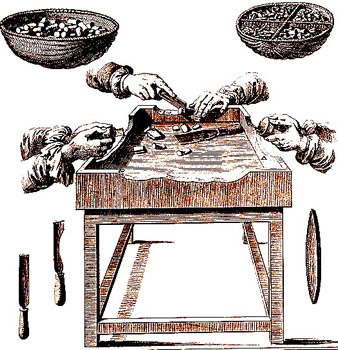
Cork Cutting Tools, From Denis Diderot's Encyclopédie (1768)
Corks during the golden age of piracy were cut by hand using very sharp knives.14 Although the general manufacture of corks didn't begin until much later in the late 1700s,15 corkcutters produced corks by as stoppers for bottles and jars in a wide variety of sizes during this time.
The household accounts of Petworth (West Sussex, England) House (a stately home in Sussex) over a period of fifty years from 1755 show payment for quart, pint, best long, best long pint, best white, short long and fruit corks. These were all acquired from a firm of London corkcutters. They were supplied in canvas bags and paid for by the gross (or the dozen in the case of fruit corks.)16
Today, most of the cork bottle stoppers seen in apothecary-style containers are tapered. During the golden age of piracy, corks were cylindrical like a modern wine cork. To insert the cork, "an apparatus called a cork press was introduced to reduce the end of the cork to fit the mouth of the bottle."17
Several sources attest to the use of corks in apothecary containers. English physician William Salmon explained
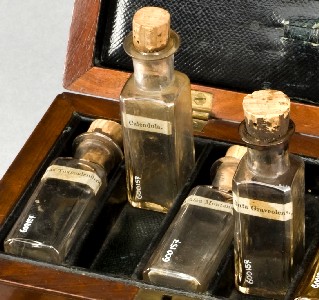
Hand cut Cylindrical Corks in Bottles In a Home Medicine Chest,
From the Wellcome Collection (19th century)
that when bottling spirit of lavender flowers, the readers should "stop the Mouth with Cork, and a little Wax melted"18. Salmon also said that salt of hartshorn (smelling salts) should be kept "in a Glass close stopt with Cork waxed over"19. The Italian medicine
chest presented to Sir John Clerk of Penicuik
in 1698 by Cosimo III of Medici, Grand Duke of Tuscany contains a variety of "glass bottles sealed with corks, and the top of each bottle is covered with parchment."20
Sea surgeon John Woodall does not give details about how to close the hundreds of containers in his medicine chest, although he did mention the use of corks in a similar capacity. He explains that when the glyster [enema] syringe is filled with medicine in preparation for use, "have ready a corke to stop the hole you put it in by: then may you lay downe your instrument till you be ready to use it."21 In his book on creating sea and military medicine chests, William Fabry gives more direct proof of the use of corks in medicine containers. He explains that "the pretious [precious] Chymical Oyls, as of Cinnamon, Cloves, Maces, Nutmegs, &c. ought to be preserv'd in double Glasses well stopt with Cork, and waxt."22
The fact that every comment directly related to medicine container corks also use wax seals suggest that cork closures were rarely used alone when a good seal was required, as it would be on long sea voyages.
1 "Why is cork traditionally used to stop wine bottles?", www.food-info.net, gathered 8/21/15; 2 Joshua Malin, "The 8,000 Year Effort To Transport Wine Around The World", vinepair.com, gathered 9/18/15; 3 Sandra Jordan with Lindsey Lee Johnson, The Art of Decanting, 2006, p. 67; 4 "The history of cork use", corkcutter.info, gathered 8/21/15; 5 "Corks - Past, Present, and Future", beekmanwine.com, gathered 8/21/15; 6 "The history of cork use", gathered 8/21/15; 7 Hugh Plat, Delights for Ladies, 1609; 8 Gervase Markham, The English Hus-wife, 1615; 9 John Beale, “Aphorisms Concerning Cider”, Printed in John Evelyn’s Sylva, 1664, p. 29; 10 Kenelm Digby, The Closet Of Sir Kenelm Digby Knight Opened, London: originally printed 1669, 1910, Anne MacDonell, ed., p. 36; 11 Jennifer Scanlan, "Pop! The History of the Champagne Cork and Cage", thisismold.com, gathered 8/24/15; 12 George M. Taber, To Cork Or Not To Cork, 2009, p. 14; 13 See Giovanni Fiorio, Queen Anna's New World of Words or Dictionarie of the Italien and English Tongues, 1611, p. 174; 14 Gito Raubenheimer, "Cork – Its History, Origin and Manufacture", Merck's Report, Vol XXI, 1912, No. 7, p. 5; 15 Walter A. Riley, "The History and Use of Corks and Other Stoppers," Journal of the Institute of Brewing, Vol. 12, Issue 3, May-June 1906 p. 173; 16 "What did corkcutters make?", corkcutter.info, gathered 8/21/15; 17 P.G. Hoffman, Royal Pharmaceutical Society, Information Sheet 3: LIQUID MEDICINES AND MEDICINE BOTTLES, 2002, p. 2; 18 William Salmon, Pharmacopoeia Bateana, 1710, p. 97; 19 Salmon, p. 497; 20 Helen Dingwall and Peter Worling, “‘A box of chymical medicines’: an Italian medicine chest presented to Sir John Clerk of Penicuik in 1698”, Journal of the Royal College of Physicians Edinburg, 2012: 42, p. 362; 21 John Woodall, the surgions mate, 1617, p. 19; 22 Guiliem. Fabritius Hildanus aka. William Fabry. Cista Militaris, Or, A Military Chest, Furnished Either for Sea or Land, 1674, p. 10
Container Closures - Glass Stopples
Glass stopples were an alternative to corks during this time. While discussing the way to make spirit of damask roses, English physician William Salmon explained that the rectified concoction "is very odiferous and grateful to the Smell, inflamable in its Substance, and of very Volatile Parts, for which reason it is to be put up into Glass Bottles with Glass Stopples."1 He advised spirit of vinegar be kept the same way.2 Apothecary John Quincy recommended that spirit of nitre be kept under glass closures.4\3 He also explained that spirit of vitriol "is extremely Caustick, and therefore is to be kept under a Wax or Glass Stopple; for Cork it will burn to a Cinder."4 Home and land-based medicine chests from after the golden age of piracy often feature glass stopples.
While not directly stated, these examples indicate that glass created a better seal than other closures.
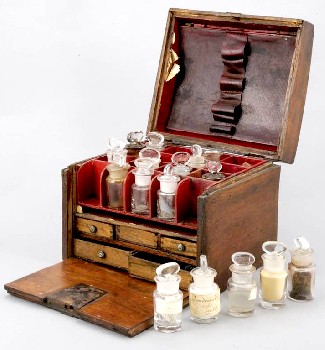
Photo: Jacques Monnen
Glass Stoppers in Home Medicine Chest (18th century)
Chemist Robert Boyle explained that for determining the specific gravity of liquids he used "a small round vial; and instead of ordinary stopple, fitting it with one of glass, carefully ground to the neck of it: for... [otherwise it would not be] penetrated by the most subtle, or corroded by the most fretting spirits... a glass stopple will not communicate any tincture, or extraneous quality to the liquor, which cannot be said of cork, or wax, in regard of some subtle, and very corrosive liquors."5
Following similar reasoning, John Worlidge advised when making cider it should be put into glass bottles. He explains the procedure for fitting the stopples in wonderful detail.
...[Y]ou may, with a Turn [lathe] made for that purpose, grind or fit Glass-stopples to each Bottle, so apt, that no Liquor or Spirit shall penetrate its closures; always observing to keep each Stopple to its Bottle: which is easily done, by securing it with a piece of Packthread [twine], each Stopple having a Button on the top of it for that end. These Stopples are ground with the Powder of the Stone Smyris, found at the Shops by the vulgar name of Emery, which with Oyl [probably olive oil] will exquisitely work the glass to your pleasure.
First grind them rough with coarse Emery, then make them smoother with fine [emery.]6
While such procedures are fine for the land-based maker of spirits, they seem to require more involvement than the average sea surgeon might have undertaken. In addition, glass stopples set in glass bottles that shifted around in their chest with the movement of the sea would seem more likely to break than those with more forgiving stoppers. None of the period sea surgeons mention using glass container closures on their bottles, which further suggest this practice may have been more appropriate to land-based medicine.
1 William Salmon, Botanologia, 1710, p. 961; 2 Salmon, p. 1229; 3 John Quincy, Pharmacopoeia Officinalis & Extemporanea, 1719, p. 277; 4 Quincy, p. 287; 5 Robert Boyle, Books, The Philosophical Works of the Honourable Robert Boyle Esq, 1725, p. 336-7; John Worlidge, Vinetum Britannicum: Or a Treatise of Cider and Other Wines and Drinks, 1678, p. 136-7
Container Closures - Wax Stopples
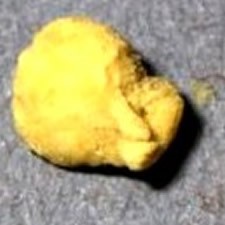
Yellow Beeswax
In the previous section, John Quincy advised that spirit of vitriol be kept "be kept under a Wax or a Glass Stopple" due to its causticity.1 He advised the same procedure for spirit of nitre.2 Wax had a long history as a container stopple. Saladin of Ascolo, author of a Compendium Aroma tariorum, a book of pharmaceuticals written in 1447 "states in the seventh chapter that the vessels were stoppered with pitch or wax."3
Such stopples would be made by heating beeswax in warm water and forming it into a plug. Nicholas Culpeper recommends that syrup of coral simplex be put "in a Glass well stopped with wax or with Cork"4.
However, such a stopple would have began to soften in warm weather, proving an unlikely way to seal medicine on voyages going to warm climates. Again, no mention is made of using wax stopples by period sea surgeons.
1 John Quincy, Pharmacopoeia Officinalis & Extemporanea, 1719, p. 287; 2 Quincy, p. 277; 3 Gito Raubenheimer, "Cork – Its History, Origin and Manufacture", Merck's Report, Vol XXI, 1912, No. 7, p. 4; 4 Nicholas Culpeper, Pharmacopœia Londinesis, 1720, p. 113
Container Closures - Pewter Screw Tops
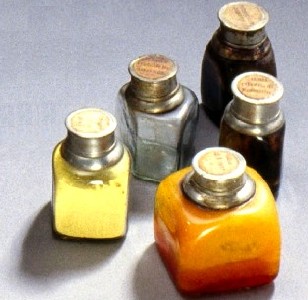
Pewter Top on Bottles in Vincenzo Giustiniani Medicine
Chest,
From the Wellcome Collection (1562-1566)
Pewter and/or lead screw tops on glass bottles date to at least the 16th century as can be seen on the Geonese Vincenzo Giustiniani Medicine Chest dated 1562-1566. The bottles in this chest "have pewter caps which screw on to pewter mounts on top of the glass part of the bottles."1 (You can see some of the bottles at right. Another view of some of the other Giustiniani bottle tops appears here.)
Bottle tops of this type were made in two pieces with the collar being permanently cast onto the glass bottle.2 The collars found aboard a shipwreck of a Spanish Navio in the 1622 Tierra Firme Fleet are "subdivided into two seamless elements: at top a narrow screw thread ...consisting of three convex external edges between two inner recessed threads for receipt of a lead cap, and below the main section ...that originally covered and protected the glass bottle neck and rim."3 These caps are designed to screw onto the collar and have a ring mounted on top of them, presumably to attach the cap to the collar so that it won't get lost.4 An example of a 17th century Dutch pewter cap without the collar which was excavated at Schuyler Flatts in New York can be seen here.
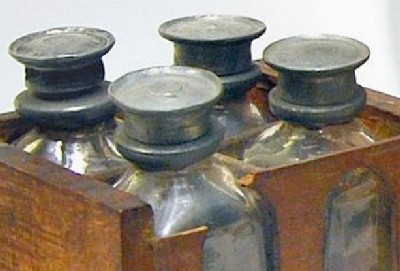
Pewter-Top Glass Bottles in Land-Based Medicine Chest in the Smithsonian (18th c.)
Such bottle tops have definite connections with sea voyages. They have been found on a variety of different sized bottles on a variety of shipwrecks. These include the Spanish Navio of the 1622 Tierra Firme Fleet, the Dutch East Indiaman Batavia wrecked in 1629, the VOC (United East India Company) Lastdrager sunk in 1653, the VOC Vergulde Draeck sunk in 1656, the Virginia Merchant sunk in 1661 and the Jutholmen shipwreck of 1700.5
Pewter-topped bottles might have been found in the medicine chest of a ship during the golden age of piracy. German surgeon William Fabry, writing about setting up sea chests for military and sea use, advised that the surgeon put "Oyls, and common Balsams, in Glass-bottles, with screwed Pewter-heads."6
1 John Burnett, The Giustiniani Medicine Chest, Medical History, 1982, 26, p. 327; 2 Greg Stemm, Ellen Gerth, et. al, "The Deep-Sea Tortugas Shipwreck, Straits of Florida: A Spanish-Operated Navio of the 1622 Tierra Firme Fleet. Part 2, the Artifacts," Odyssey Papers 27, Odyssey Marine Exploration, 2013, p. 14; 3 Stemm, Gerth, et. al, p. 13; 4 Stemm, Gerth, et. al, p. 14; 5 Stemm, Gerth, et. al, p. 14-15

